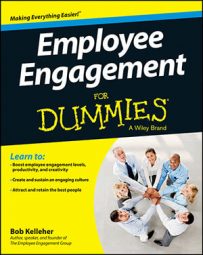A key aspect of employee engagement is motivation — why people do what they do. A person may be motivated by any number of things: to attain status or money, to help others, to find meaning in life, or simply to express herself.
There is a difference between someone who's motivated intrinsically and someone who's motivated extrinsically. As an employer, you need to understand the key drivers of intrinsic motivation (in case you hadn't guessed, this is the kind you're after). Motivated to find out more? Read on!
According to psychology types, there are two types of motivation:
Extrinsic (external ) motivation: Extrinsic motivation comes from outside a person. For employees, the most obvious form of extrinsic motivation is money. Every paid job on this planet involves extrinsic motivation, whether in the form of salary, tips, commission, benefits, stock options, bribes, table scraps, or some combination thereof.
Another example of extrinsic motivation is the threat of punishment. For example, an employee who regularly shows up late will be fired; so, fear of being fired may serve as an extrinsic motivation.
Companies often use extrinsic motivation to encourage specific behaviors, such as competitiveness or punctuality. When people talk about engaged employees having both their heads and their hearts in their jobs, extrinsic motivation is the “head” part of that equation.
Intrinsic ( internal ) motivation: Intrinsic motivation comes from within. It's driven by a personal interest or enjoyment in the task itself.
For example, suppose you enjoy playing the pan flute, and you want to improve your skills. That's an example of an intrinsic motivation. You don't want to become a better pan-flute player so you can be a world-famous musician — you simply want, for your own personal reasons, to improve your pan-flute skills because you enjoy playing the pan flute.
With intrinsic motivation, the result is often growth — for example, growth as an intellectual journey or growth due to challenges that have been overcome. When people talk about engaged employees having both their heads and their hearts in their jobs, intrinsic motivation is the “heart” part of that equation.
Both extrinsic and intrinsic motivation play a role in building a culture of engagement. Obviously, extrinsic motivation (in the form of money) is important — after all, people need to be paid in order to put food on the table. But intrinsic motivation plays an even greater part in the world of employee engagement.
The fact is, intrinsically motivated employees are more likely to be engaged in what they're doing than their counterparts who rely only on extrinsic motivation to put a spring in their step. Moreover, intrinsically motivated employees are more likely to go above and beyond — to put in that discretionary effort.
Interestingly, as noted by author Daniel H. Pink in his book Drive: The Surprising Truth About What Motivates Us (Riverhead), organizations that place too much emphasis on extrinsic rewards often discover their employees do less.
In addition, over-reliance on extrinsic rewards often leads to undesirable behaviors and an erosion of any intrinsic behaviors. For proof, look no further than the financial market collapse of 2008 –2009, during which there were countless examples of what happens when the focus shifts disproportionately to personal and organizational rewards.
At the root of the collapse of our financial institutions were countless examples of organizational greed made worse by a systematic lack of organizational and regulatory checks and balances.

